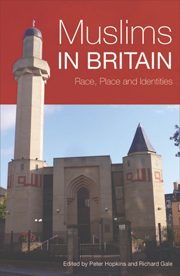Book contents
- Frontmatter
- Contents
- Acknowledgements
- List of contributors
- List of tables
- List of figures
- 1 Introduction: Muslims in Britain – race, place and the spatiality of identities
- Section 1 Gender, place and culture
- 2 Creating home spaces: young British Muslim women's identity and conceptualisations of home
- 3 ‘You seem very westernised to me’: place, identity and othering of Muslim workers in the UK labour market
- 4 Rethinking the identities of young British Pakistani Muslim women: educational experiences and aspirations
- 5 Race, ‘face’ and masculinity: the identities and local geographies of Muslim boys
- Section 2 Landscapes, communities and networks
- Section 3 Religion, race and difference
- Afterword
- Index
2 - Creating home spaces: young British Muslim women's identity and conceptualisations of home
from Section 1 - Gender, place and culture
Published online by Cambridge University Press: 05 August 2013
- Frontmatter
- Contents
- Acknowledgements
- List of contributors
- List of tables
- List of figures
- 1 Introduction: Muslims in Britain – race, place and the spatiality of identities
- Section 1 Gender, place and culture
- 2 Creating home spaces: young British Muslim women's identity and conceptualisations of home
- 3 ‘You seem very westernised to me’: place, identity and othering of Muslim workers in the UK labour market
- 4 Rethinking the identities of young British Pakistani Muslim women: educational experiences and aspirations
- 5 Race, ‘face’ and masculinity: the identities and local geographies of Muslim boys
- Section 2 Landscapes, communities and networks
- Section 3 Religion, race and difference
- Afterword
- Index
Summary
Introduction
This chapter explores the interrelationship between expressions of ‘self’ and the creation of ‘home spaces’ among young, mostly working-class, Muslim women living in a range of family circumstances in the northern textile towns of Oldham, Rochdale and Bradford. It is particularly concerned with the feelings and experiences of those moving into new spaces, but it also explores how ‘self’ can be expressed through the creation of autonomous home spaces within the family home. While acknowledging that the concept of ‘home’ should not simply be conflated with that of housing, the discussion focuses on the meaning of living arrangements and housing circumstances for young Muslim women's identity. The notion of home space is used here to embrace the idea of both housing and the neighbourhood. Both may be seen as material and affective spaces that play a role in shaping everyday practices, social relations and identities of young Muslim women in Britain.
Explorations of the concept of home reveal it to be ambiguous and evocative, with multiple meanings (Rose 1993; Domosh 1998; Blunt and Dowling 2006). Home is a place that is both lived and imagined, with material characteristics and symbolic significance. Experiences and understandings of home are likely to be underpinned by social differences, such as age, gender, education, ethnicity, sexuality etc., and to vary with social, political and cultural contexts. Homes become imbued with different emotions and meanings at different times, depending on the intersection between ideas of self and family, community and other associations which help to shape a sense of connectedness and belonging.
- Type
- Chapter
- Information
- Muslims in BritainRace, Place and Identities, pp. 23 - 36Publisher: Edinburgh University PressPrint publication year: 2009



